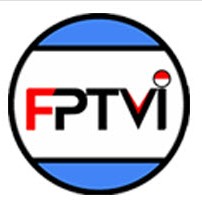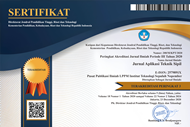Pemodelan Simulasi Bobot Risiko Rantai Pasok Material Struktur dengan Metode Monte Carlo pada Konstruksi Sektor Gedung
Abstract
Keywords
Full Text:
PDFReferences
C. Kaliba, M. Muya, and K. Mumba, “Cost escalation and schedule delays in road construction projects in Zambia,” International Journal of Project Management, vol. 27, no. 5, pp. 522–531, 2009, doi: https://doi.org/10.1016/j.ijproman.2008.07.003.
K. Alrasheed, E. Soliman, and H. Albader, “Systematic review of construction project delays in Kuwait,” Journal of Engineering Research, vol. 11, no. 4, pp. 347–355, 2023, doi: https://doi.org/10.1016/j.jer.2023.08.009.
P. L. Le, I. Jarroudi, T.-M. Dao, and A. Chaabane, “Integrated construction supply chain: an optimal decision-making model with third-party logistics partnership,” Construction Management and Economics, vol. 39, no. 2, pp. 133–155, Feb. 2021, doi: 10.1080/01446193.2020.1831037.
R. Vrijhoef and L. Koskela, “The four roles of supply chain management in construction,” European Journal of Purchasing & Supply Management, vol. 6, no. 3, pp. 169–178, 2000, doi: https://doi.org/10.1016/S0969-7012(00)00013-7.
S. N. Bahagia, “Harmonisasi Konstruksi Indonesia yang Berwawasan Lingkungan,” in Harmonisasi rantai pasok konstruksi, Konsepsi, Inovasi, dan APlikasi di Indonesia, 2012.
F. L. Ribeiro and J. Lopes, “Association of Researchers in Construction Management,” 2001.
W. Z. W. Abdullah and Siti Rashidah Mohd Nasir, “Supply chain integration issues and challenges in industrialised building system (IBS) construction projects in Malaysia,” Malaysian Construction Research Journal, vol. 22, no. 2, pp. 73–83, 2017.
E. M. A. C. Ekanayake, S. G. Q. P, K. M. M, O. E. K, and S. A. B, “Modeling Supply Chain Resilience in Industrialized Construction: A Hong Kong Case,” J Constr Eng Manag, vol. 147, no. 11, p. 05021009, Nov. 2021, doi: 10.1061/(ASCE)CO.1943-7862.0002188.
L. J. Susilo and V. R. Kaho, Manajemen Risiko Berbasis ISO 31000:2018 ; Panduan untuk Risk Leaders dan Risk Practitioners. PT. Gramedia Widiasarana Indonesia: PT. Gramedia Widiasarana Indonesia, 2018.
W. Ho, T. Zheng, H. Yildiz, and S. Talluri, “Supply chain risk management: a literature review,” Int J Prod Res, vol. 53, no. 16, pp. 5031–5069, Aug. 2015, doi: 10.1080/00207543.2015.1030467.
N. Viswanadham and R. S. Gaonkar, “Risk Management in Global Supply Chain Networks,” in Supply Chain Analysis: A Handbook on the Interaction of Information, System and Optimization, C. S. Tang, C.-P. Teo, and K.-K. Wei, Eds., Boston, MA: Springer US, 2008, pp. 201–222. doi: 10.1007/978-0-387-75240-2_8.
D. Aloini, R. Dulmin, V. Mininno, and S. Ponticelli, “Supply chain management: a review of implementation risks in the construction industry,” Business Process Management Journal, vol. 18, no. 5, pp. 735–761, Jan. 2012, doi: 10.1108/14637151211270135.
L. Rzepecki, “Optimization of inventory costs management in the construction enterprise,” IOP Conf Ser Mater Sci Eng, vol. 603, no. 3, p. 032046, 2019, doi: 10.1088/1757-899X/603/3/032046.
N. Čuš-Babič, D. Rebolj, M. Nekrep-Perc, and P. Podbreznik, “Supply-chain transparency within industrialized construction projects,” Comput Ind, vol. 65, no. 2, pp. 345–353, 2014, doi: https://doi.org/10.1016/j.compind.2013.12.003.
X. Meng, “Assessment framework for construction supply chain relationships: Development and evaluation,” International Journal of Project Management, vol. 28, no. 7, pp. 695–707, 2010, doi: https://doi.org/10.1016/j.ijproman.2009.12.006.
R. Vrijhoef and L. Koskela, “The four roles of supply chain management in construction,” European Journal of Purchasing & Supply Management, vol. 6, no. 3, pp. 169–178, 2000, doi: https://doi.org/10.1016/S0969-7012(00)00013-7.
H. T. Pham, T. Pham, H. Truong Quang, and C. N. Dang, “Supply chain risk management research in construction: a systematic review,” International Journal of Construction Management, vol. 23, no. 11, pp. 1945–1955, Aug. 2023, doi: 10.1080/15623599.2022.2029677.
W. Ho, T. Zheng, H. Yildiz, and S. Talluri, “Supply chain risk management: a literature review,” Int J Prod Res, vol. 53, no. 16, pp. 5031–5069, Aug. 2015, doi: 10.1080/00207543.2015.1030467.
P. Behera, R. P. Mohanty, and A. Prakash, “Understanding Construction Supply Chain Management,” Production Planning & Control, vol. 26, no. 16, pp. 1332–1350, Dec. 2015, doi: 10.1080/09537287.2015.1045953.
Momin M. H, Mulgund G V, and Kanade G N, “Uncertainty In Supply Chain In Construction Projects – A Case Study,” International Journal of New Technologies in Science and Engineering, vol. 2, no. 2, 2015.
R. Oktavia, Irwandi, Rajibussalim, M. Mentari, and I. S. Mulia, “Assessing the validity and reliability of questionnaires on the implementation of Indonesian curriculum K-13 in STEM education Assessing the validity and reliability of questionnaires on the implementation of Indonesian curriculum K-13 in STEM education,” Journal of Physics, 2018, doi: 10.1088/1742-6596/1088/1/012014.
T. D. Moshood, A. Q. Adeleke, G. Nawanir, and F. Mahmud, “Ranking of human factors affecting contractors’ risk attitudes in the Malaysian construction industry,” Social Sciences and Humanities Open, vol. 2, no. 1, p. 100064, 2020, doi: 10.1016/j.ssaho.2020.100064.
C. P. Malkewitz, S. Philipp, M. Christian, and H. Jochen, “Estimating reliability A comparison of Cronbach’s α McDonald’s ωt and the greatest lower bound,” 2022. [Online]. Available: https://doi.org/10.1016/j.ssaho.2022.100368
L. R. Debataraja, A. Suraji, and T. Ophiyandri, “Analisis Risiko Investasi Infrastruktur Berbasis Fuzzy Analytical Hierarchy Process (F-AHP) Fuzzy Analytical Hierarchy Process (F-AHP) For Risk Assesment In Infrastructure Investment,” 2020.
L. R. Debataraja, “Analysis of Human Factors that Influence Contractors’ Risk Management Attitudes in Sumatra Island in Construction Projects,” Journal of Civil Engineering and Planning, vol. 4, no. 2, pp. 162–172, Dec. 2023, doi: 10.37253/jcep.v4i2.8575.
DOI: http://dx.doi.org/10.12962%2Fj2579-891X.v23i2.21786
Refbacks
- There are currently no refbacks.

Jurnal Aplikasi Teknik Sipil by Pusat Publikasi Ilmiah LPPM Institut Teknologi Sepuluh Nopember is licensed under a Creative Commons Attribution-ShareAlike 4.0 International License
Based on work at https://iptek.its.ac.id/index.php/jats




